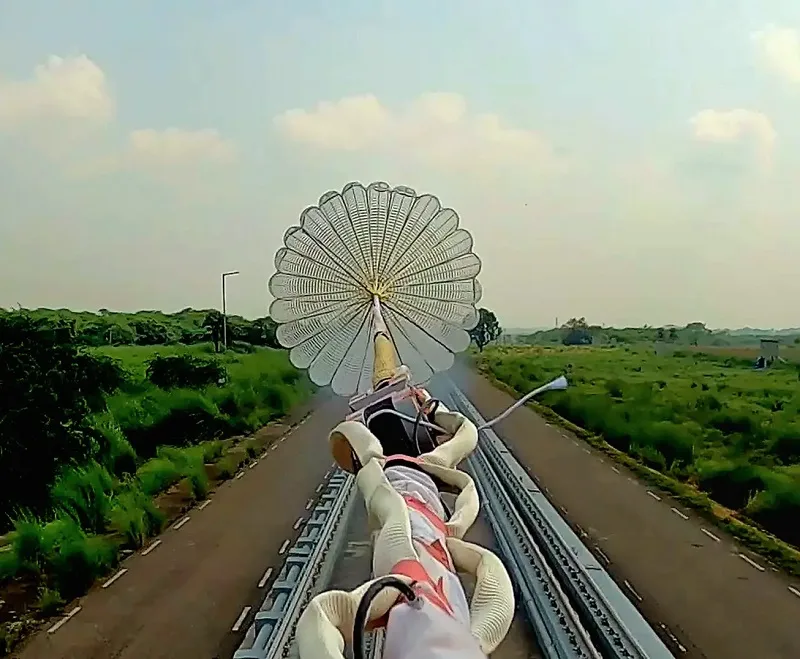

Drogue parachutes play a pivotal role in stabilizing the crew module and reducing its velocity to a safe level during re-entry (Images courtesy: ISRO)
Vikram Sarabhai Space Centre (VSSC), the lead centre for launch vehicles development in Indian Space Research Organisation (ISRO) successfully conducted a series of Drogue Parachute Deployment Tests this week, further accentuating the progress of the Gaganyaan mission’s parachute system development.
ISRO revealed that the three comprehensive tests were conducted for three consecutive days starting Tuesday at the Rail Track Rocket Sled (RTRS) facility of the Terminal Ballistics Research Laboratory in Chandigarh.
The tests were done in collaboration with the Aerial Delivery Research and Development Establishment (ADRDE) – a pioneer R&D lab of Defence Research and Development Organisation (DRDO) for the design and development of aerodynamic decelerators and aerostat systems.


“The Gaganyaan mission entails the safe transportation of astronauts to space and back. A crucial component of this mission is the deployment of drogue parachutes, which play a pivotal role in stabilizing the crew module and reducing its velocity to a safe level during re-entry,” said ISRO in a statement.
India’s maiden human space flight ‘Gaganyaan’ is targeted to be launched in the fourth quarter of 2024.
Drogue parachutes, packed within pyro-based devices known as mortars, are ingeniously designed to eject the parachutes into the air upon command. These conical ribbon-type parachutes, boasting a diameter of 5.8 meters, employ a single-stage reefing mechanism, ingeniously minimizing canopy area and mitigating opening shock, ensuring a smooth and controlled descent.
During the tests conducted at the RTRS facility, a range of real-world scenarios were simulated to rigorously evaluate the performance and reliability of the drogue parachutes.
“The first test simulated the maximum reefed load, marking a groundbreaking introduction of reefing in a mortar-deployed parachute within India. The second test emulated the maximum disreefed load, while the third test showcased the deployment of the drogue parachute under conditions mirroring the maximum angle of attack experienced by the Crew Module during its mission,” ISRO detailed.
These successful RTRS tests, including those of pilot and apex cover separation parachutes, serve as a critical qualification milestone for the drogue parachutes, confirming their readiness for integration into the upcoming Test Vehicle-D1 mission.
The intricate parachute sequence for the Gaganyaan crew module’s deceleration system encompasses a total of 10 parachutes. The sequence commences with the deployment of two Apex cover separation parachutes, followed by the stabilization achieved through the deployment of two drogue parachutes.
Upon release of the drogue parachutes, the mission transitions into the extraction phase, with three Pilot chutes individually extracting three main parachutes, a pivotal step in reducing the Crew Module’s speed to safe levels for a secure landing.
As India continues to get World support against the Pahalgam Terror attack that killed 26…
Union Minister of Industry and Supply Piyush Goyal on Saturday highlighted the success of a…
In a display of outrage following the Pahalgam terror attack, thousands from the Indian community…
In a continued crackdown following the Pahalgam terror attack, security forces and Jammu and Kashmir…
In a massive statewide crackdown, over 550 illegal immigrants from Bangladesh were detained in Ahmedabad…
The Deputy Chief of the Main Operations Directorate of the General Staff of the Russian…